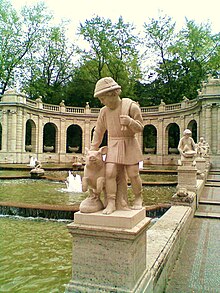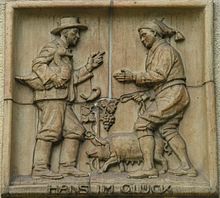Hans in hapiness


Hans im Glück is a Schwank ( ATU 1415). It is in the children's and house fairy tales of the Brothers Grimm from the 2nd edition of 1819 at position 83 (KHM 83) and comes from the magazine Wünschelruthe , where August Wernicke published it a year earlier (year 1818, issue 33) under the title Hans Wohlgemut had published. Ludwig Bechstein took over the story in his German fairy tale book as Hans im Glücke (1845 No. 24, 1853 No. 22).
content
Hans receives a head-sized lump of gold for seven years of work. He exchanges this for a horse, the horse for a cow, the cow for a pig, the pig for a goose, and he gives the goose for a grindstone and a simple field stone. He has the feeling of swapping in such a way that everything arrives that he wishes for, and feels favored by happiness “like a Sunday child ”. Finally, when he is about to drink, the two heavy stones fall into a well. Finally he is happy not to have to carry the heavy stones anymore.
“As happy as I am, he exclaimed, 'there is no man under the sun. With a light heart and free from all burdens, he went away until he got home to his mother. "
style

The speeches, with which everyone here knows how to pull Hans over the table and which are always a realistic hymn of praise to the advertised everyday goods , are always suitable to amuse the audience.
In the Brothers Grimm's collection, Hans im Glück is one of the fairy tales that, unlike almost half of the fairy tales there, does not begin with the traditional Once Upon a Time ... But this is definitely the case in Bechstein's version.
Interpretations
The fairy tale allows for several popular interpretations ("teachings") that are obvious, for example: "Only simplicity finds happiness" or "To be free is more than good and money" or " mundus vult decipi " ( lat. , "the world wants to be betrayed"). Artistically this is to be seen as a strength. The philosopher Ludwig Marcuse wrote about Hans im Glück :
“… One has luck neither in gold nor in pigs nor in stones. A lot can make you happy; but no good makes you happy in every respect. "
According to Viktor, Hans' behavior contradicts all logic and convention, which is irritating. His ease in dealing with others stands in contrast to the consistency of his path to the “Great Mother” , who is the grave. His animals also belong to their symbolic circle. Wolfdietrich Siegmund thinks that Hans im Glück warns against the questionable barter deals of life, but at the same time encourages people to transform painful disappointments into comforting certainty of the meaning of fate. Wilhelm Salber remarks that the fairy tale calls for a return. Homeopaths compared the fairy tale with the medicines Agaricus , Aurum , Magnesium carbonicum . Siegfried Stadler ironically provides a Marxist interpretation. In the motivation theory interpretation from a management point of view, Hans is a “self-serving hedomat and pain-avoiding happiness economist”. Karen Lippert points to the possibility of two opposing modes of interpretation. Only in one of these is Hans the simpleton in happiness and the story a vacillation about his stupidity. Another interpretation is that of happiness by overcoming a material worldview. In this interpretation, Hans gradually frees himself from possessions and constraints such as dragging heavy lumps, having to worry about animals or a life as a traveling craftsman. In this reading, Hans has perfected the principle of positive thinking and recognizes himself as his most valuable possession, which ultimately makes him happy.
There are also interpretations from other disciplines (philosophy, philology, depth psychology, political science, economics).
Receptions
Ludwig Bechstein's Hans im Glücke in Deutsches Märchenbuch has been reformulated, otherwise very similar down to the details. It follows Grimm's version, even if Bechstein still mentions “ Chamisso's poem” in the Musenalmanach for the year 1832 (1831). He took over a scissors-grinder song from Anton Wilhelm von Zuccalmaglios and Andreas Kretzschmer's German folk songs in their original ways , 1838.
In 1832 Adelbert von Chamisso created an arrangement in verse under the title Hans im Glücke . The Danish writer Henrik Pontoppidan tragically worked on the motif in his multi-volume novel Hans im Glück (1898–1904, German 1906). Oleg Konstantinowitsch Popov's clown role shows parallels to Hans im Glück . In Janosch's parody, Hans sees everything as positive, e.g. B. when he only receives a goose from the master, which runs away from him, when he loses a leg in the war ("Two legs away is worse!") And his wife runs away.
Film adaptations
- 1936: Hans im Glück , Germany, the fairy tale was made into a film by the two film architects Robert Herlth and Walter Röhrig as directors. Anton Weber was primarily responsible for the buildings . The main actors at that time were Rudolf Biebrach , Lola Chlud , Erich Dunskus , Käthe Haack , Georgia Holl , Erwin Linder , Rudolf Platte , Eugen Re , Oskar Sima and Elsa Wagner .
- 1949: Hans im Glück , BR Germany, film version as a kind of musical. Direction: Peter Hamel with Gunnar Möller , Erich Ponto , Gertrud Kückelmann , Werner Lieven , Beppo Brem and Rudolf Vogel .
- 1956: Hans im Glück , BR Germany, TV production by the Augsburger Puppenkiste , b / w
- 1976: Hans im Glück , BR Germany, television play, director: Wolfgang Petersen with Jürgen Prochnow , Peter Schiff , Sigrid Lagemann and Andreas Hanft . Only the title agrees with the fairy tale - the plot is about a young man who, despite big plans and offensively exhibited excessive self-confidence, ends up failing both professionally and privately.
- 1999: Hans im Glück , Germany, fairy tale film, director: Rolf Losansky with Andreas Bieber , Marlene Marlow and the comedians Karl Dall and Kalle Pohl .
- 2006: Hans im Glück - exchange frenzy in the fairy tale forest , Germany / Austria, parody from the ProSieben / ORF series Die Märchenstunde with Christian Ulmen , Ingo Appelt , Nora Tschirner and Joseph Hannesschläger .
- 2016: Hans im Glück , Germany, fairy tale film of the 9th season from the ARD series Six in One Stroke from 2016. First performed on November 12, 2015 at the Lünen Kinofest.
Thematic use of the title :
- 1987: Hans im Glück (TV series) does not deal with fairy tales.
- 2009: Hans im Glück , 19-minute short film by Peter Hümmeler , it was made as a student film in the fourth semester at the International Film School in Cologne and was shown at the Landshut Short Film Festival , among others .
- 2009: Hans im Glück , film by Claudia Lehmann , contribution to the Berlinale 2009, family history 20 years after the fall of the Berlin Wall
music
- The composer and lyricist Roland Zoss set Hans im Glück to music in the Swiss dialect fairy tale series Liedermärli
literature
- Heinz Rölleke (Ed.): Grimm's fairy tales and their sources. The literary models of the Grimm fairy tales are presented synoptically and commented on. Second improved edition. Literature series, Volume 35. Wissenschaftlicher Verlag Trier, Trier 2004, ISBN 3-88476-717-8 , pp. 110–121, 559.
Web links
- Gutenberg-DE: Bechstein's Hans in luck
- Interpretation by Daniela Tax on Hans im Glück
- Illustrations
- Hans im Glück as mp3 audio book on LibriVox
- Lucky Jack in the Internet Movie Database (English)
Individual evidence
- ↑ University Days 2008
- ↑ University Days 2008
- ↑ Ludwig Marcuse: Philosophy of happiness. P. 45, Diogenes, Zurich, 1972, ISBN 3-257-20021-8 .
- ^ Viktor aiming: Hans in luck. Love of life instead of the burden of life. 1st edition. Kreuz Verlag, Zurich 1987, ISBN 3-268-00043-6 .
- ↑ Frederik Hetmann: dream face and magic trace. Fairy tale research, fairy tale studies, fairy tale discussion. With contributions by Marie-Louise von Franz, Sigrid Früh and Wolfdietrich Siegmund. Fischer, Frankfurt am Main 1982, ISBN 3-596-22850-6 , p. 122.
- ^ Wilhelm Salber: fairy tale analysis (= work edition Wilhelm Salber. Volume 12). 2nd Edition. Bouvier, Bonn 1999, ISBN 3-416-02899-6 , p. 121.
- ^ Martin Bomhardt: Symbolic Materia Medica. 3. Edition. Verlag Homeopathie + Symbol, Berlin 1999, ISBN 3-9804662-3-X , pp. 53, 212, 836.
- ^ Siegfried Stadler: Marx's fairy tales. In: Die Horen. Vol. 1/52, No. 225, 2007, ISSN 0018-4942 , pp. 211-216.
- ↑ Rolf Wunderer: Puss in Boots as an entrepreneur, lessons from management and fairy tales - Chapter 5 Hans in happiness. Pp. 119-164, Wiesbaden, 2008, ISBN 978-3-8349-0772-1 .
- ↑ Karen Lippert: Märchenaltas Retrieved July 12, 2019
- ↑ Rolf Wunderer: Motivation in fairy tales and management - Hans im Glück - self-motivated as well as action-motivated benefit maximizer and pain-avoiding emotional engineer. in: fairytale mirror. 19th vol., H. 1, 2008, pp. 2-25.
- ^ Hans-Jörg Uther (Ed.): Ludwig Bechstein. Storybook. After the edition of 1857, text-critically revised and indexed. Diederichs, Munich 1997, ISBN 3-424-01372-2 , p. 385.
- ^ Adelbert von Chamisso Hans im Glücke In: Deutscher Musenalmanach, 3rd year, 1832 digitized
- ↑ Janosch: Hans in luck. In: Janosch tells Grimm's fairy tale. Fifty selected fairy tales, retold for today's children. With drawings by Janosch. 8th edition. Beltz and Gelberg, Weinheim and Basel 1983, ISBN 3-407-80213-7 , pp. 5-8.
